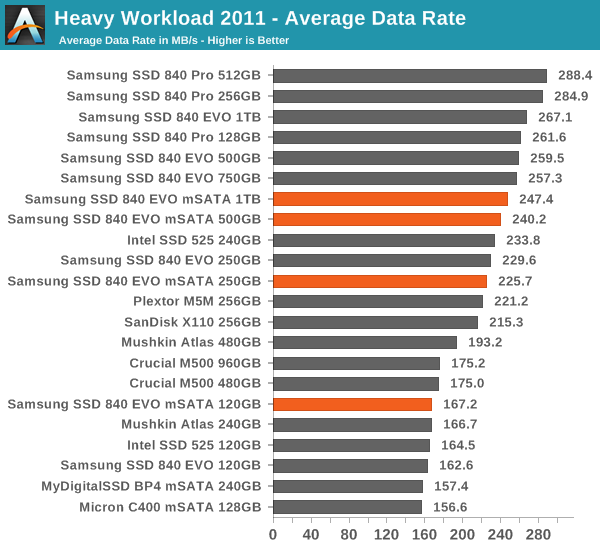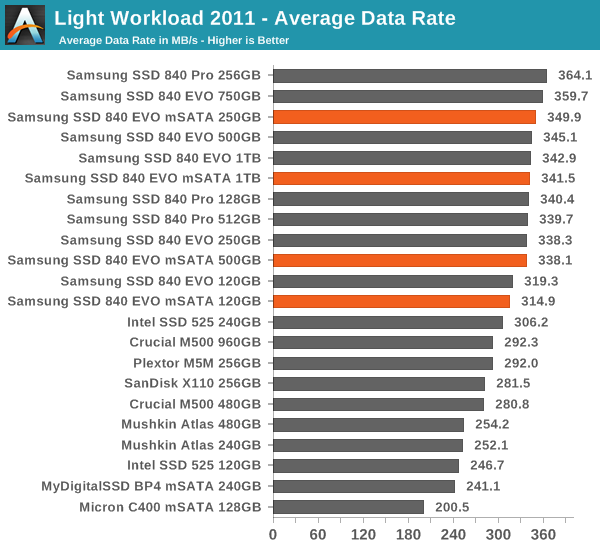Samsung SSD 840 EVO mSATA (120GB, 250GB, 500GB & 1TB) Review
by Kristian Vättö on January 9, 2014 1:35 PM ESTAnandTech Storage Bench 2011
Two years ago we introduced our AnandTech Storage Bench, a suite of benchmarks that took traces of real OS/application usage and played them back in a repeatable manner. Anand assembled the traces out of frustration with the majority of what we have today in terms of SSD benchmarks.
Although the AnandTech Storage Bench tests did a good job of characterizing SSD performance, they weren't stressful enough. All of the tests performed less than 10GB of reads/writes and typically involved only 4GB of writes specifically. That's not even enough exceed the spare area on most SSDs. Most canned SSD benchmarks don't even come close to writing a single gigabyte of data, but that doesn't mean that simply writing 4GB is acceptable.
Originally the benchmarks were kept short enough that they wouldn't be a burden to run (~30 minutes) but long enough that they were representative of what a power user might do with their system.
1) The MOASB, officially called AnandTech Storage Bench 2011 - Heavy Workload, mainly focuses on the times when your I/O activity is the highest. There is a lot of downloading and application installing that happens during the course of this test. Our thinking was that it's during application installs, file copies, downloading and multitasking with all of this that you can really notice performance differences between drives.
2) We tried to cover as many bases as possible with the software incorporated into this test. There's a lot of photo editing in Photoshop, HTML editing in Dreamweaver, web browsing, game playing/level loading (Starcraft II & WoW are both a part of the test) as well as general use stuff (application installing, virus scanning). We've included a large amount of email downloading, document creation and editing as well. To top it all off we even use Visual Studio 2008 to build Chromium during the test.
The test has 2,168,893 read operations and 1,783,447 write operations. The IO breakdown is as follows:
| AnandTech Storage Bench 2011 - Heavy Workload IO Breakdown | ||||
| IO Size | % of Total | |||
| 4KB | 28% | |||
| 16KB | 10% | |||
| 32KB | 10% | |||
| 64KB | 4% | |||
Only 42% of all operations are sequential, the rest range from pseudo to fully random (with most falling in the pseudo-random category). Average queue depth is 4.625 IOs, with 59% of operations taking place in an IO queue of 1.
AnandTech Storage Bench 2011 - Heavy Workload

The full data set including disk busy times and read/write separation can be found in our Bench.
AnandTech Storage Bench 2011 - Light Workload
Our light workload actually has more write operations than read operations. The split is as follows: 372,630 reads and 459,709 writes. The relatively close read/write ratio does better mimic a typical light workload (although even lighter workloads would be far more read centric). There's lots of web browsing, photo editing (but with a greater focus on photo consumption), video playback as well as some application installs and gaming.
The I/O breakdown is similar to the heavy workload at small IOs, however you'll notice that there are far fewer large IO transfers. Interestingly, the 480GB drive actually comes out ahead in this case, suggesting it's more capable at light workloads.
| AnandTech Storage Bench 2011 - Light Workload IO Breakdown | ||||
| IO Size | % of Total | |||
| 4KB | 27% | |||
| 16KB | 8% | |||
| 32KB | 6% | |||
| 64KB | 5% | |||











65 Comments
View All Comments
Brenderick - Saturday, February 15, 2014 - link
mSata was what the commenter wanted.MoFoQ - Friday, January 10, 2014 - link
same hardware?The mSATA version has 4 NAND packages.
The 2.5" version has 8.
Sure, the number of dies total might be the same.
It's like comparing two houses of the same square-footage....except one of them is a two-story house and the other, a single-story one.
With that said, it is an interesting development for mSATA SSDs.
I can't wait until other manufacturers come to market to help drive the price down.
emvonline - Friday, January 10, 2014 - link
16 die packages are possible at all NAND suppliers and it is relatively straight forward to implement. the issue is usually that there is minimal demand for anything requiring it. What percentage of the market is 1TB? I think we are talking less than 3% above 512G for consumers. let me know if I am wrong.TLC is great for Samsung product margins. so far it hasn't led to a cost decrease for consumers.
Samsung's execution is the amazing part. they have good (or great) products in every market at every density. And they have the most aggressive marketing campaign. No one else has been able to achieve this.
Marrixster - Saturday, January 11, 2014 - link
Thanks very much indeed for this review. I already have 2 Samsung PM851 512GB (MZMTE512HMHP-00000). And, just prior to reading this review ordered the 1TB model (MZ-MTE1T0BW).The price is AUD822.99 (ramcity.com.au), very expensive. However, the convenience of this form factor justifies cost from my point of view.
Now, it's simply a matter of deciding which lappy it gets installed in.
Unit Igor - Saturday, January 11, 2014 - link
Tell me Kristian please would EVO 120GB msata have any advantage over EVO 250gb msata in longer battery life when you compare power consumption vs. disk busy times and mb/s.I use my ultrabook only for mails ,sometimes watching movies and surfing.I dont need more then 120GB SSD but i am willing to buy 250Gb if it would give me more battery life.What i wanted to see in your benchmark is MobileMark 2012 because msata is for laptops and that is where battery life play big role.philipma1957 - Sunday, January 12, 2014 - link
the new gigabyte brix with the i7 4770r cpu 16th ram and a 1tb mSata would be really nice gear.nogoms - Monday, January 13, 2014 - link
You start off with the claim that "Samsung is in a unique position in the SSD market. It’s the only company in the consumer SSD business with a fully vertically integrated business model and zero reliance on other companies."This is, however, not actually true. SK Hynix is in a similar position, as they've had their own controllers, NAND, and DRAM since their purchase of LAMD a year and a half ago. Admittedly, they hadn't actually released a completely in-house SSD using a LAMD controller until late last year with the release of the SH 920 series. In fact, the Surface Pro 2 uses an SK Hynix mSATA SSD (with a LAMD controller), as noted in Anand's review and iFixIt's teardown. SK Hynix also doesn't appear to be making the SH920 series available in retail outside of Asia, though Super Talent's Supernova3 series is available in retail in North America (from the likes of SuperBiiz and various third-party sellers on Amazon and Newegg) and appears to be rebranded 2.5" SK Hynix SH920 series drives.
Kristian Vättö - Monday, January 13, 2014 - link
I did mention SK Hynix and LAMD later in the article:"Sure, Samsung isn't the only NAND manufacturer but it is the only one with a consumer orientated controller IP (although SK Hynix owns LAMD now but that deal has yet to materialize in a product)"
The thing is, while Hynix does have a LAMD based SSD, it's the same controller that other's are using. It's possible that Hynix has contributed to the firmware but it's not a fully in-house designed platform (the controller was designed way before the acquisition took place).
nogoms - Monday, January 13, 2014 - link
That statement is also false, as SK Hynix's LAMD controller *has* materialized in products, as I pointed out in my previous post--they're available in complete systems like the Surface Pro 2 worldwide as well as standalone at retail (in East Asia). Also, it's disingenuous to say it's not fully in-house when the controller and firmware were designed and written by teams currently in the employ of SK Hynix, and even if one were to accept your contention that such an arrangement is not "fully in-house designed," the opening statement of the article does not all of a sudden become true, as Samsung is still not the only manufacturer with "a fully integrated business model" or "zero reliance on other companies."Hrel - Monday, January 13, 2014 - link
any idea when we'll be able to get 512GB drives for under $200?